In March, one of our planners, Claudia Kousoulas, showed the difference in scale between urban development and the infrastructure underlying suburban development by overlaying the I-270/I-370 interchange on top of Bethesda’s Woodmont Triangle area.
The amount of space we devote to moving cars is almost surreal at times. At Montrose Road, Interstate 270 is a whopping 14 lanes wide. At that rate, it seems we’re trying to rival places like Atlanta and Los Angeles.
But what is even more amazing is the amount of space we devote to storing cars. When people think of the automobile, it is invariably involved in going somewhere. But cars spend the vast majority of their time parked.
In Montgomery County, we devote about 2.5% of our land area to parking. That’s more than 12 square miles. It’s slightly less than the amount of land covered by water in the county. Can you imagine the Potomac River, and the Triadelphia, Rocky Gorge, and Little Seneca reservoirs all covered in parking lots?
Perhaps more shocking is that the amount of space we devote to parking and driving exceeds the amount of land devoted to buildings in Montgomery County.
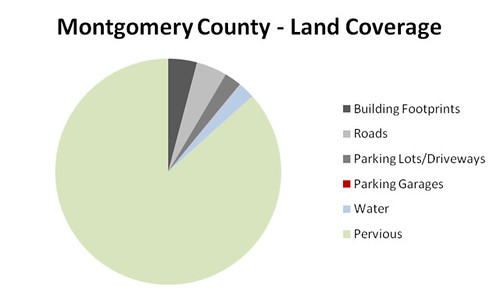
Buildings cover about 4.1% of the county’s land. But roadways cover 4.3%, meaning that we use 6.8% of the area of the county just to move or store automobiles.
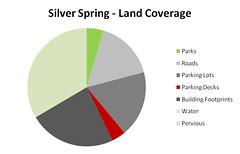 Silver Spring is one of Montgomery County’s urban areas. There we find that 21.9% of the land area of the Central Business District is devoted to parking cars. Most of that area is surface parking. Only 3.8% of the land area of the CBD is used for structured parking. Another 16% of the land area is used for roadways.
Silver Spring is one of Montgomery County’s urban areas. There we find that 21.9% of the land area of the Central Business District is devoted to parking cars. Most of that area is surface parking. Only 3.8% of the land area of the CBD is used for structured parking. Another 16% of the land area is used for roadways.
In fact, four times as much area is devoted to surface parking than is devoted to parks in the Silver Spring CBD.
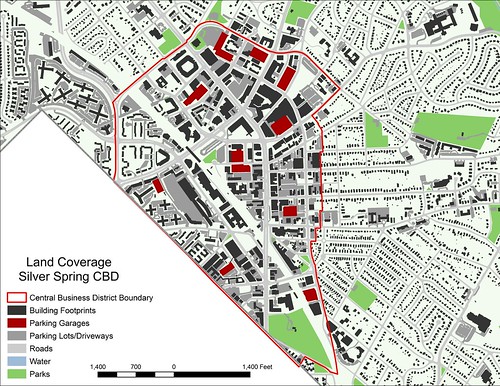
In White Flint, along the suburban Rockville Pike corridor, the numbers are even more extreme. I used the boundaries of the recent sector plan area to calculate the percentages.
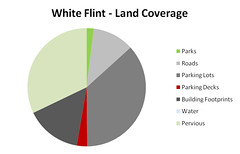 There, some 45.9% of the land area is devoted to parking. Another 13.2% is devoted to roadways, meaning that 59.1% of the land area of the neighborhood is given over to cars.
There, some 45.9% of the land area is devoted to parking. Another 13.2% is devoted to roadways, meaning that 59.1% of the land area of the neighborhood is given over to cars.
Here, the lack of a parking lot district makes shared parking much more difficult. And that means that each business is providing more spaces than would be needed in a “park once” district.
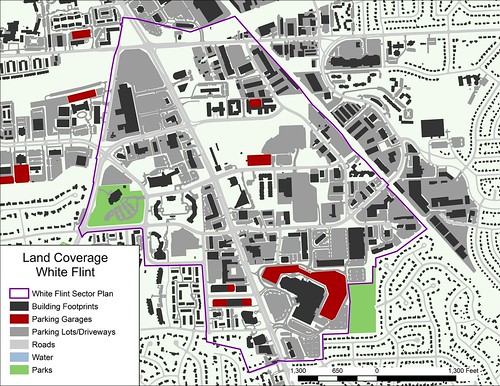
All told, approximately 34.6 square miles of land area in Montgomery County is devoted to automotive transportation. If all the roads and parking areas in Montgomery County were placed in Arlington County, Virginia, they would completely fill Arlington, and there would still be 10 square miles of parking and roads left over. Or, placed in Washington, they would cover over half of the land area in the District.
Accommodating this sea of parking places a huge cost on both the public and private sectors. And it also has a major impact on the environment. But perhaps most notable is the opportunity cost of using valuable land in our activity centers for parking. In White Flint, despite the presence of a Metro station, 45.9% of the land area is devoted to parking. Only 17.7% of the land is used for buildings!
As the county grows more dense, the acres of parking in places like White Flint are becoming more valuable as potential sites for redevelopment. How we address the parking issue will have an enormous impact on the future of the county.
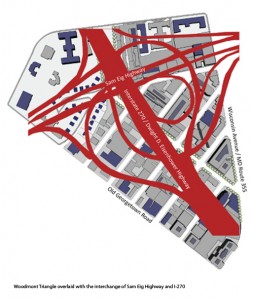
Jimmy
Just as an example of how quickly Silver Spring is urbanizing, the map you have is already out of date. The King Street lot and the private lot by the Aurora on 13th St have both been closed to make way for a new apartment building, which will have underground parking. Construction on The Galaxy has already begun.
Bob
Has the proportion of land devoted to transportation really changed that much from the pre-automobile era? If you compare streets and parking now to streets, stables, and land devoted to growing all the crops eaten by horses, etc. then, it might not be that different.
BeyondDC
Bob, You are projecting current ideas back on the past. People in the pre-car era didn’t ride around on horses the way we ride around in cars today. Horses were owned by a much much smaller portion of the population (especially in cities).
Bob
Maybe, but the answer would still be interesting to know. The street network would be pretty much the same, per-capita, I would imagine. And it took a lot of space to support the animals that were used. Allso, many, if not most, single family houses in the pre-auto period (as opposed to tenements and apartment buildings) had their own stables. Commercial stables were also widely available….rent-a-horse or horse and carriage.
But the point that people didn’t get around as much is undoubtedly true. We are much more mobile than we were pre-automobile, even with public transportation in the pre-auto cities. Our ability to get from place to place relatively quickly and cheaply in ways we couldn’t before has to represent a major increase in our standard of living.
Our goal shouldn’t be to favor either cars or public transportation, or bikes, or horses for that matter Our goal should be to provide the most convenient transportation possible at the lowest cost. For some trips that is the car, for others, public transportation, for others walking, bikes, etc., or a combination of methods. (And by the way, I’ve commuted at various times using each of those methods, and also a moped. Never commuted by horse, though.)
tuppenceforthebirds
The 3.8% of land dedicated structured parking is a bit misleading. While many buildings have structured parking, much of it prominently exposed (see: The Veridian), the 3.8% refers to land used solely for parking garages. That figure is higher when you consider structured parking in terms of buildable land, by eliminating land currently dedicated to parks and roads.
For me, this is more egregious than the surface parking which, while impervious and unsightly, is temporary. These parking lots represent the low-hanging fruit for the continued urbanization of the Silver Spring, White Flint, etc. Single-purpose structured parking, on the other hand, erode the urban fabric that the Planning Department is trying to encourage.
In Silver Spring, the Wayne Avenue, Cameron Street, and Colesville Road/Spring Street Garages are the worst offenders. Compare the amount of pedestrian traffic on Ellsworth and on Wayne Avenue. They are night and day. The Colesville Road garage is similarly bad, while the Cameron Street garage impedes the logical flow of pedestrian traffic from northern Silver Spring to the Metro station. The Metro Garage over Bonifant Street longs like haven for all things undesirable.
The revitalization of places like White Flint and Silver Spring will be reliant to some degree on pulling people out of the suburban homes, getting them to drive to an “urban area” to perform multiple activities, errands, etc. that they otherwise would have done with multiple car trips. To that end, structured parking is a more efficient solution to meet parking demand. However, these garages are best enjoyed by pedestrians (and those of us without cars) when they are underground, or otherwise undetectable from the street. The County should have a policy restricting the construction of stand-alone garages, and redevelop their existing structures for residential or commercial uses (with the parking included) as part of future revitalization efforts.
Real urban areas seem to be able to do this, why can’t we?
georgek
The last post describes the dilemma of parking garages: they allow the concentration of visitors to a dense urban setting, but they are typically the least urban friendly of buildings. Unfortunately, Montgomery County is often a horrible patron of better architecture and a review of what is being done with garages around the country would show that what is wrong is not the building type, but our expectations for it, architects and other stakeholders.
Also, zoning requirements are harmful. Often the most difficult task in initial planning of a building, say apartments, is how to “park it”, i.e., fulfill the space and dimensional requirements for parking based on building use. What if street parking in abutting residential areas were protected by permits (to prevent cannibalization), the requirements for buildings (occupancies) were lowered substantially and providing the balance of spaces left as a business decision